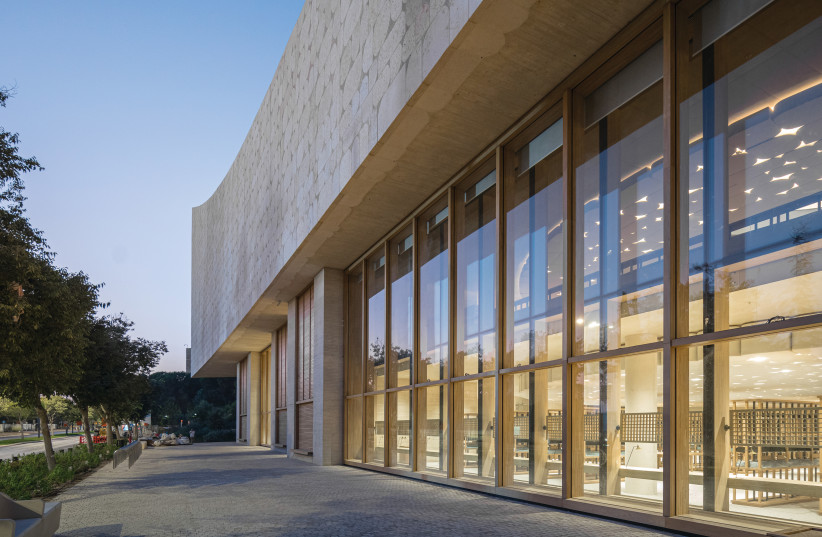Modern technology has made it possible to see many of the world’s treasures without ever leaving home. Yet no matter how many photographs and videos from every possible angle and how many eloquent texts have been placed at our disposal, nothing actually beats being there and seeing the real thing.
Judging by the unusually large-scale response to an invitation to a press tour of the new 11-story National Library of Israel in Jerusalem, there is broad consensus for the notion that reality triumphs over the digital world.
In my own case, it was more than that. I had covered the laying of the cornerstone for the library in April 2016, had interviewed one of the key donors, and had eagerly been following developments ever since.
Close to 50 journalists gathered in a large, well-furnished meeting room where the history of the National Library flashed before their eyes on a giant video screen. Some of the library’s staff and board members were seeing this for the first time. They had seen photographs, but the non-stop screening was something completely new, and an effective introduction to every visitor, enabling comparison of the library in its former abode on the Givat Ram Safra campus of the Hebrew University, with its new majestic home.
Every day, there are new signs of progress
The library’s director general Oren Weinberg said that with every passing day, there are new signs of progress. He appeared to be familiar with every detail – reeling off up-to-date facts and figures about the environment, the architects, the architecture, the construction, and the company responsible for it; creative solutions for lighting and sound; and heating in winter, as well as many other features.

Throughout the tour, Weinberg emphasized the importance of transparency and ease of access. Windows everywhere allow visitors and staff to see what’s happening above and what’s happening underground, or for that matter what is happening in offices. All the doors are made of glass with wooden frames. But the initial sight is of the enormous rotunda-style bookcases on different floors, with a reader seating capacity of 600 at any given time. On the upper floor, we initially stopped at the German section in front of volumes by Heinrich Heine, Berthold Brecht, Karl Kraus, and others.
According to Weinberg, the library has books and manuscripts in 200 languages.
We went down to the next floor, taking the stairs, because the elevators were still not working. The perspective from there was totally different from what we had experienced upstairs.
In the former premises of the National Library, there was a large hall in which seating was on rows of chairs all at the same level.
In its current home, the library has a 480-seat auditorium, built on a steep gradient, which means that even someone vertically challenged and sitting behind a tall person will not have their view blocked. In addition to the rotunda, there are other differently sized and shaped reading areas, including one with a sunken floor. There’s also an amphitheater in the spacious garden outside, and plans are afoot for frequent and varied cultural events, to bring increasing numbers of people to the library.
The very high ceilings of the new National Library add to the grandeur of the project. Yet it’s not an imposing kind of grandeur, rather, it’s friendly and inviting, and taking into account the varied parts of the complex, there’s something for everyone, including young children. Working in conjunction with the Education Ministry, the National Library has numerous programs and activities for school children. It’s important to catch them young so that they learn from an early age to love books and enjoy reading them.
Books aside, techies will be fascinated by all the state-of-the-art technology that has gone into making the National Library one of the most user-friendly places in the country.
Weinberg took us to an area resembling an atrium, the site of a future coffee shop where it would be relatively easy to sit down and chat with an Israel Prize laureate. Elsewhere in the building, there’s a larger space designated for a restaurant.
The National Library, due to the undulating terrain of Jerusalem, has an upper entrance from Kaplan Street, and a lower entrance from Ruppin. It is conveniently situated across the road from the Knesset, and five minutes walk away from the Israel Museum and the Bible Lands Museum.
The gallery is a very spacious room, studded with showcases with digitized copies of Jewish and other newspapers and manuscripts from around the world, some dating back five centuries and more. The showcases are placed far apart so that visitors have plenty of room in which to inspect their contents.
There are also seals from various eras and places, and different styles of script which can be examined with the use of a large, high-powered magnifying glass that slides along two poles. The gallery also has sections with biographical details for famous rabbis, philosophers, poets, and novelists, and there are both permanent and changing exhibitions.
Impressive as everything was, the gallery was by far my favorite place, and it was obvious that I was not the only one transfixed by it.
As a souvenir of the tour, we were each given a tote bag marked with a quote from philosopher Martin Buber: “After you have visited the library 10 times to look at books, go once to look at the readers… see the features, gestures, and postures of each. Thus you will be able to learn something you will probably not be able to learn as well anywhere else: Books are great, but man is greater.”
